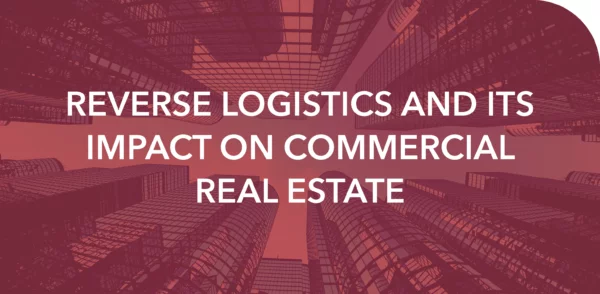REVERSE LOGISTICS AND ITS IMPACT ON COMMERCIAL REAL ESTATE
February 12, 2021

Reverse Logistics
It has been said that the best way to test a system is to observe it during its most stressful periods. When it comes to forward logistics, we witnessed the agility and adaptability of supply chains throughout the early- and later-stage of the pandemic. Early on, businesses struggled to provide alternative purchasing options and distribution bandwidths were stretched thin. Weeks and months later, retailers pivoted to or strengthened their online platforms while logistics firms increased the capacities and delivery times of their networks. These necessary adjustments allowed us to safely operate within the constraints of social distancing and health protocols.
However, as we come out of those uncertain times, we see an emerging trend that is not only posing challenges to the bottom-lines of retailers but also affecting long-term sustainability. What was once considered a periodic phenomenon during Holiday shopping seasons has become a year-round issue. Increases in transportation costs, product depreciation, product waste, crowded warehouses, and growing landfills are but a few of its effects.
The problem: the return of goods.
Managing High Consumer Expectations
Brick-and-mortar retailers, while less convenient than online shopping, offer the ability to see, touch, and try on dozens of items to ensure the best fit, size, and appearance. With consumers avoiding physical locations, many have gotten into the habit of purchasing ‘try on’ items with the intention of returning items they don’t like.
Research firm Statista estimates that between 15% to 30% of online purchases are returned, a figure 2 to 3 times higher than items bought in-store.
And in an age where consumers expect same- or next-day delivery, as well as the ability to return items at no-cost, retailers need to factor in a positive and risk-free buying experience into their business models.
What are Reverse Logistics?
According to Wikipedia, “reverse logistics is for all operations related to the reuse of products and materials. It is the process of moving goods from their typical final destination for the purpose of capturing value, or proper disposal. Remanufacturing and refurbishing activities also may be included in the definition of reverse logistics.”
Reverse Logistics firm Optoro estimates that:
- Retailers require 4-7x more space during peak periods;
- Online returns are 3x higher than brick-and-mortar returns;
- $428B worth of inventory was returned in 2020;
- 5.8B lbs of returns ended up in landfills;
- 16M metric tons of CO2 emitted from transportation of returns;
- E-commerce returns produce 14% more landfill waste than brick-and-mortar returns.
And when leveraging a reverse logistics solution:
- 4.68M lbs of carbon emissions prevented by reducing transportation and increasing efficiency in the reverse supply chain
- $3.23M of inventory donated to those in need; and
- 3.21M lbs of waste diverted from landfills by giving retailers solutions to manage and resell inventory
The Effects of Reverse Logistics on Commercial Space
For Retailers or 3PLs:
- Short-term overflow space demand;
- Need for long-term, strategically-located warehousing;
- Demand for Class A space to fulfill forward logistics; and
- Use of Class B space to process returns and reselling/recommerce.
For Landlord or Investors:
- Increased general demand for industrial space;
- Lower vacancies in Class B space;
- Growing ecosystem and industry of returns processing;
- Demand for Class A space built-to-suit or on spec;
Summary
Reverse logistics has emerged as a key process to recapture margin and revenues through the reselling of inventory while, at the same time, providing a superior experience to customers.
However, as e-commerce sales continue to grow, so does the issue of returned items. Moving forward, retailers will need to look for elegant solutions that can solve for the increases in transportation costs, product depreciation, and already-stressed supply chains.
One thing is for certain, though. No matter where goods are bought, sold, returned, or re-routed through distribution networks, demand for industrial real estate will continue to strengthen.
Overall, a range of Tenants in the retailing, distribution, and logistics industries will be looking to bolster their supply chains through their real estate portfolios while Landlords and Investors continue to seek sound opportunities in which to invest.
Given the already historically-low vacancy rates in the Greater Toronto Area industrial market, finding a warehouse or distribution facility to achieve these goals may take several months or even years. Proactively staying in contact with a commercial real estate agent can help you stay ready should the need or opportunity arise.

